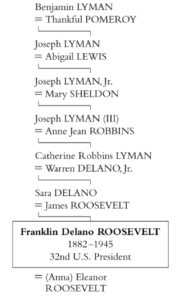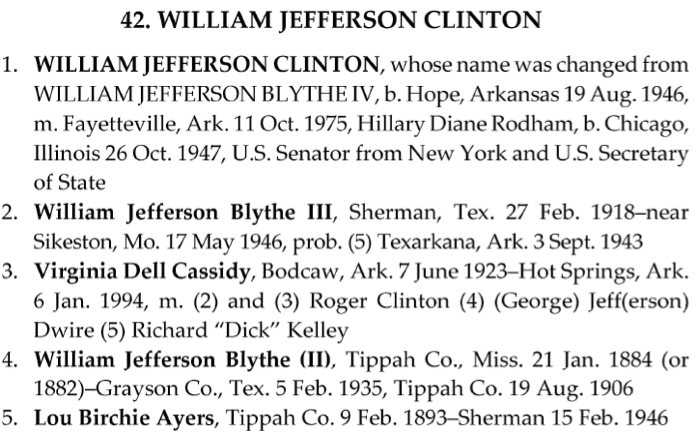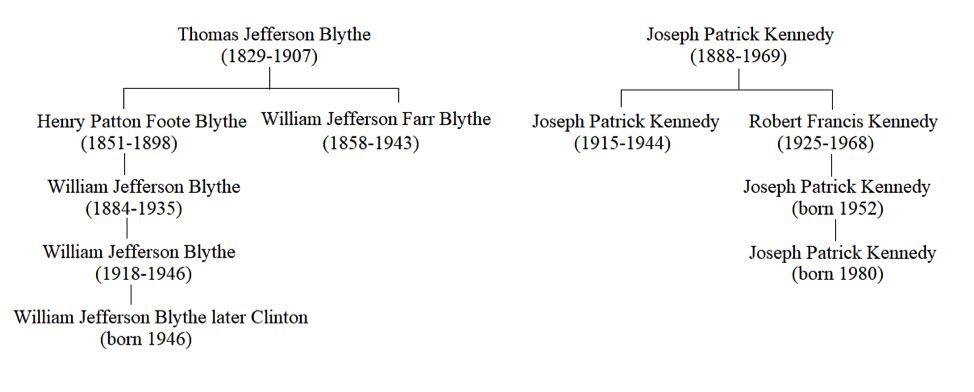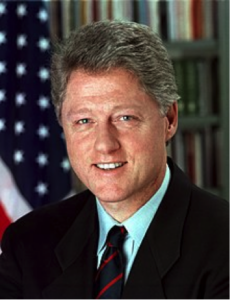 An occasional question I receive relates to two practices used in publications by my longtime friend and colleague, Gary Boyd Roberts, that I would summarize as retroactive suffixes and surnames. The latter is used in many other genealogical compendia, largely in relation to royal genealogy (which I’ll discuss in part two of this post), while the former is perhaps less common, and used more often in identifying Americans after 1620. I would identify Gary as belonging to “Team Present,” in terms of using a modern genealogical naming system for past eras, while Vita Brevis editor Scott Steward would belong to “Team Contemporary” in trying to identify people by the names they used in their lifetimes. I would put myself in “Team Whatever,” usually omitting suffixes entirely, except when their contemporary identification is useful to determine how they might fit genealogically into a family.
An occasional question I receive relates to two practices used in publications by my longtime friend and colleague, Gary Boyd Roberts, that I would summarize as retroactive suffixes and surnames. The latter is used in many other genealogical compendia, largely in relation to royal genealogy (which I’ll discuss in part two of this post), while the former is perhaps less common, and used more often in identifying Americans after 1620. I would identify Gary as belonging to “Team Present,” in terms of using a modern genealogical naming system for past eras, while Vita Brevis editor Scott Steward would belong to “Team Contemporary” in trying to identify people by the names they used in their lifetimes. I would put myself in “Team Whatever,” usually omitting suffixes entirely, except when their contemporary identification is useful to determine how they might fit genealogically into a family.
Examples of retroactive suffixes can be seen in many charts we have put together in Ancestors of American Presidents, largely for ease of identification. In this chart section at right, for the three men named Joseph Lyman in the ancestry of Franklin Delano Roosevelt, the second is given the suffix Jr. and the third is given the suffix “(III),” based on how one might use suffixes today. All three Josephs principally lived in Northampton, Massachusetts. Did either of the two younger Josephs actually use those suffixes? The youngest Joseph Lyman (1767-1847), who was a judge of probate court, used the “Jr.” suffix, such as in the 1800 census, until his father’s death in 1804, after which, such as in the 1810 census, he was simply “Joseph Lyman.” His gravestone has him inscribed as “Hon. Joseph Lyman” (in reference to his service as a judge), even though the findagrave summary uses the retroactive “III” suffix. The middle Joseph Lyman (1731-1804) likewise only used the “Jr.” suffix until the death of his father in 1763 and is buried as “Capt. Joseph Lyman.” Also, the use of the suffix “Jr.” not only denotes that these men were father and son, but they were the younger of two individuals of the same name living in the same town, as I had described in a prior post on my own ancestors. I understand using the suffixes in a modern lens may be visually appealing, and useful from an organizational standpoint.
However, probably the two cases where I have gotten the most questions relate to Gary’s “retroactive” suffixes for two well-known modern political figures who themselves used different suffixes. The first regards U.S. President Bill Clinton, who was born in 1946 as William Jefferson Blythe III, son of William Jefferson Blythe Jr. (who had died three months prior to his son’s birth) and Virginia Dell Cassidy, who later married secondly (and thirdly), Roger Miles Wister Clinton (1909-1967), prompting the younger William to use the surname Clinton in childhood, with a formal change when the future president was fifteen. As stated in the president’s late mother’s 1994 autobiography, her son was born in with the suffix “III,” and her late husband used the suffix “Jr.” (and was the son of an earlier William Jefferson Blythe). However, when David Curtis Dearborn and other colleagues researched then president-elect Clinton’s ancestry in 1992 for Gary’s “Notable Kin” column in NEXUS (our previous magazine), it was discovered Clinton’s paternal grandfather was named for his uncle William Jefferson Farr Blythe, and so the president’s birth name was “renumbered” from III to IV.
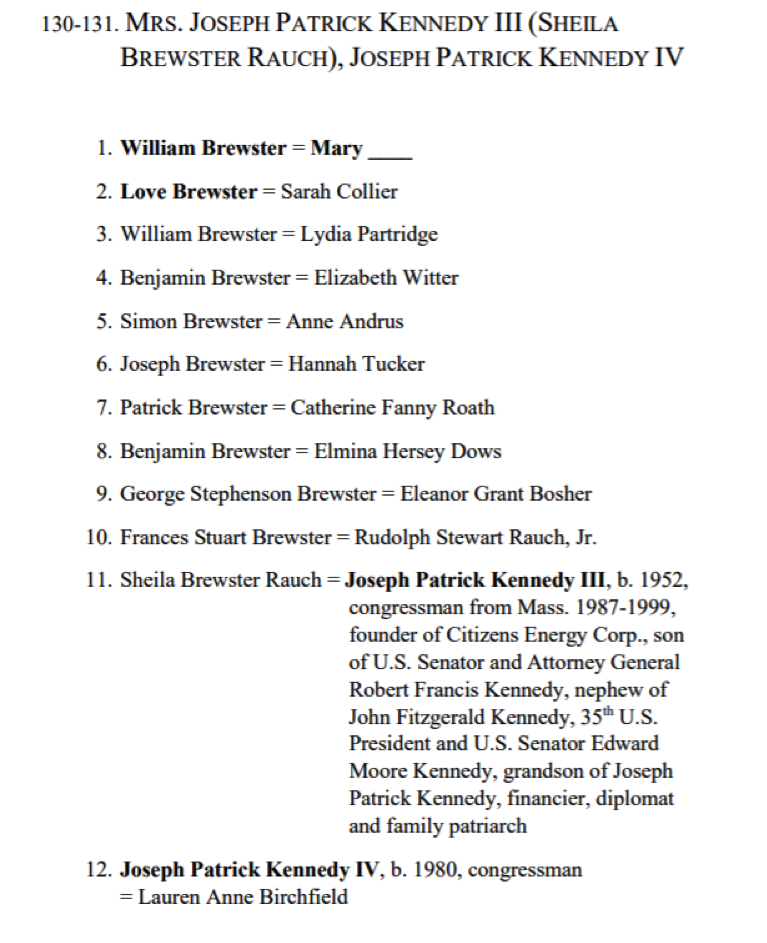 The other example concerns former U.S. Congressman Joseph Patrick Kennedy (born 1980), of the fourth generation of the Massachusetts Kennedy family. The politician has always used the suffix “III,” and his father (also a Congressman) has used the suffix “II” (in reference to his paternal grandfather Joseph Patrick Kennedy, father of the late president). However, Gary counts the president’s older brother Joseph Patrick Kennedy, Jr. (1915-1944), who is not ancestral to the last two Josephs, and thus renumbers “II” to “III,” and “III” to “IV,” such as in his recent The Mayflower 500, where he outlines the youngest Joseph’s descent (through his mother) from Mayflower passengers William, Mary, and Love Brewster.
The other example concerns former U.S. Congressman Joseph Patrick Kennedy (born 1980), of the fourth generation of the Massachusetts Kennedy family. The politician has always used the suffix “III,” and his father (also a Congressman) has used the suffix “II” (in reference to his paternal grandfather Joseph Patrick Kennedy, father of the late president). However, Gary counts the president’s older brother Joseph Patrick Kennedy, Jr. (1915-1944), who is not ancestral to the last two Josephs, and thus renumbers “II” to “III,” and “III” to “IV,” such as in his recent The Mayflower 500, where he outlines the youngest Joseph’s descent (through his mother) from Mayflower passengers William, Mary, and Love Brewster.
All this goes to say, this is a personal style choice Gary has used in his career for genealogical organization and identification purposes. This chart I made below outlines each of the four men with the same name, suffixes intentionally omitted.
Concluded here.
Share this:
About Christopher C. Child
Chris Child has worked for various departments at NEHGS since 1997 and became a full-time employee in July 2003. He has been a member of NEHGS since the age of eleven. He has written several articles in American Ancestors, The New England Historical and Genealogical Register, and The Mayflower Descendant. He is the co-editor of The Ancestry of Catherine Middleton (NEHGS, 2011), co-author of The Descendants of Judge John Lowell of Newburyport, Massachusetts (Newbury Street Press, 2011) and Ancestors and Descendants of George Rufus and Alice Nelson Pratt (Newbury Street Press, 2013), and author of The Nelson Family of Rowley, Massachusetts (Newbury Street Press, 2014). Chris holds a B.A. in history from Drew University in Madison, New Jersey.View all posts by Christopher C. Child →
